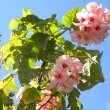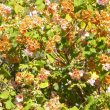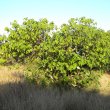Dombeya burgessiae
| Botanical Name | Dombeya burgessiae |
|||||||||||||||||||||
| Family | Sterculiaceae - The cocoa and cola family. |
|||||||||||||||||||||
| Pronunciation | DOM-bee-yuh bur-JESS-ee-ay |
|||||||||||||||||||||
| Common Name(s) |
English: Pink wild pear; Pink dombeya
Afrikaans: Persdrolpeer
IsiZulu: iBunda
Tshivenda: Mupfulwi
|
|||||||||||||||||||||
| Plant Group |
|
|||||||||||||||||||||
| Plant Size |
|
|||||||||||||||||||||
| Position |
|
|||||||||||||||||||||
| General Information |
|
|||||||||||||||||||||
| Specific Information | Dombeya burgessiae has large, velvety, lobed leaves which create a lush, tropical effect. It is versatile as it can be grown in shade, making it an effective shrub/tree for a water garden or mini-forest. In full flower the tree is covered by a blanket of pale pink. After flowering, the flowers turn golden brown, remaining on the tree for some time, and making an attractive display. Dombeya burgessiae is very fast growing and can reach full size in three years. The specimen in the photos above does not do the tree justice as it is planted out of its ideal environment and has had to cope with minimal water, long droughts and high winds. If any one is able to add a picture of Dombeya burgessiae in its full glory, I would be most appreciative. |
|||||||||||||||||||||
| Ad Break | ||||||||||||||||||||||
| Flowers | ||||||||||||||||||||||
| Description | dense clusters of five-pointed saucer-shaped petals |
|||||||||||||||||||||
| Season |
|
|||||||||||||||||||||
| Colour |
|
|||||||||||||||||||||
| Growth Rate |
|
|||||||||||||||||||||
| Plant Uses |
|
|||||||||||||||||||||
| Distribution and Habitat | from KwaZulu-Natal to Mpumalanga and Limpopo, northwards to Tanzania, on forest margins, hillsides and slopes, and along stream banks |
|||||||||||||||||||||
| Planting Suggestions | Plant in full sun or light shade in garden soil to which compost has been added. Add fertilizer according to your soil needs if necessary. The old method of digging a deep hole and filling it with soil and compost has resulted in many trees failing to thrive, dying, rotting at the base or worse still, falling over in later years due to poor root development. Refer to the following sites for the best method of planting trees: International Society of Arboriculture: New Tree Planting Tree People: Plant the right way For those of you who have a clay problem try: |
|||||||||||||||||||||
| Medicinal Uses | No data found. |
|||||||||||||||||||||
| Ad Break | ||||||||||||||||||||||








Discuss this plant
Share knowledge, ask a question or give an experience.